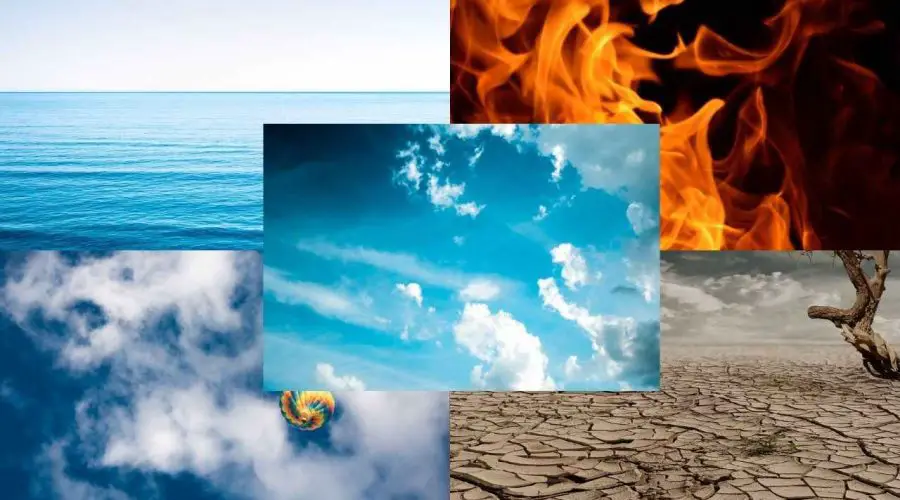What is the Panch Bhutas: Know the Five Elements of Life
Pancha Bhutas is the source of the five great elements. The Sanskrit term bhutas means “subtle essence.” The five main elements are formed by these bhutas. Each big element is made up of all five tanmatras (bhutas), but one tanmatra dominates.
Sound (Shabda), Touch (Sparsha), Vision (Roopa), Taste (Rasa), and Smell (Rasa) are the five tanmatras (Gnadha). Each sensory organ is represented by a tanmatra.
According to Ayurveda, the components and functions of nature are analogous to the components and functions of our bodies. Everything in the physical universe is made up of these five components, according to the Pancha Mahabhuta doctrine. Akash is the first element to appear in the universe (Ether). It is the most open and least concreate of them all.
Vayu (Air) is the next element to be generated, followed by Agni (Fire), Jala (Water), and finally Prithvi (Earth).
Akash (Ether) :
When we think of Ether, we think of phrases like space or enormous openness. Akash refers to a cavity that is free to move around. Shabda is the ether element’s tanmatra (Sound). When molecules are compact, we hear a dull sound when we tap them, but when there is a hole or empty space, we hear a resonant sound.
The ether element has transparent, light, subtle, and unfathomable properties. The ether element is linked to a variety of actions, such as expansion, vibration, and non-resistance. The ear is a sensory organ associated with the ether element since it is hollow and transmits sound waves.
Vayu (Air):
The excellent element that demonstrates mobility is air. Vayu, or air, is responsible for initiating and directing motion. The element of air keeps the body moving.
Sparsha is the Air element’s tanmatra (Touch). The skin is the sense organ associated with the element Air. Skin is extremely sensitive to tiny movements, changes in pressure, and vibrations. Any movement against the skin is easily detectable.
In nature, the air element is mobile, dry, light, cold, and subtle. Its primary function is to move in any direction.
Tej (Fire):
Air, the previous element, performs various movements; whenever there is movement, friction occurs, resulting in the development of heat or fire. Teja or agni are other names for this element. The fire element is responsible for many types of transformations, including food digestion.
Rupa is the fire element’s tanmatra (Vision). This tanmatra is in charge of light perception. The fire element is fiery, crisp, light, dry, and understated.
This element performs a variety of activities, including penetration, food digestion, mental transformation, intelligence, and light perception.
Jala (Water):
Water is the fourth element. It’s also known as Apa or Jala. When we think of water, we think of properties like liquidity and fluidity. Water is a crucial binding quality; for example, we can’t build a ball out of dry dirt. We may simply generate mud balls if we add water to the earth. Because it connects the two cells together, this binding nature aids in the formation of various structures in the body. As a result, this element is a positive force.
The water element’s tanmatra is rasa (taste). The sense of taste, or the capacity to taste, is reliant on saliva, which is a liquid that exists in the mouth. Dry mouth and tongue are unable to provide a feeling of taste. The water element has properties such as coolness, liquidity, dull softness, and sliminess. Cohesiveness and adhesiveness are two of its primary functions.
Prithvi (Earth):
This is the final component. It’s solid, dense, filthy, and quite hard. It refers to any solid or hard structure that has a shape, such as bones, muscles, teeth, or nails. The Earth element is in charge of giving the body structure, shape, and strength.
Gandha is the tanmatra for the Earth element (Smell). The little particles of dirt spread around the area provide us with a sense of smell. The nose is the sensory organ involved. In comparison to other sense organs, the nose is more difficult. The earth element has the qualities of being heavy, dull, dense, hard, and gross.
Frequently Asked Questions
1. What are the five elements or Pancha Bhutas?
Earth, water, fire, air, and ether are the five elements that makeup both the individual human body and the greater cosmic body.
2. What does ether mean in the Bible?
Ether is divided into fifteen chapters. The title alludes to Ether, a Jaredite prophet who lived near the end of the book’s historical period, which is thought to be between 2600 and 2100 BC and 600 BC or later, spanning at least 1500 years but potentially as much as 2500.
3. Are there 4 or 5 elements?
In mediaeval alchemy, the number of customary ingredients fluctuates between 4, 5, and 8. The first four are always found. In some cultures, the fifth element, aether, is significant. Classic elements include sulphur, mercury, and salt.
4. What is my weakest chakra?
The Third Chakra, also known as the Solar Plexus Chakra, is placed between the navel and the sternum and is your weakest chakra. Confidence, willpower, self-esteem, and ego are all linked to this chakra.

